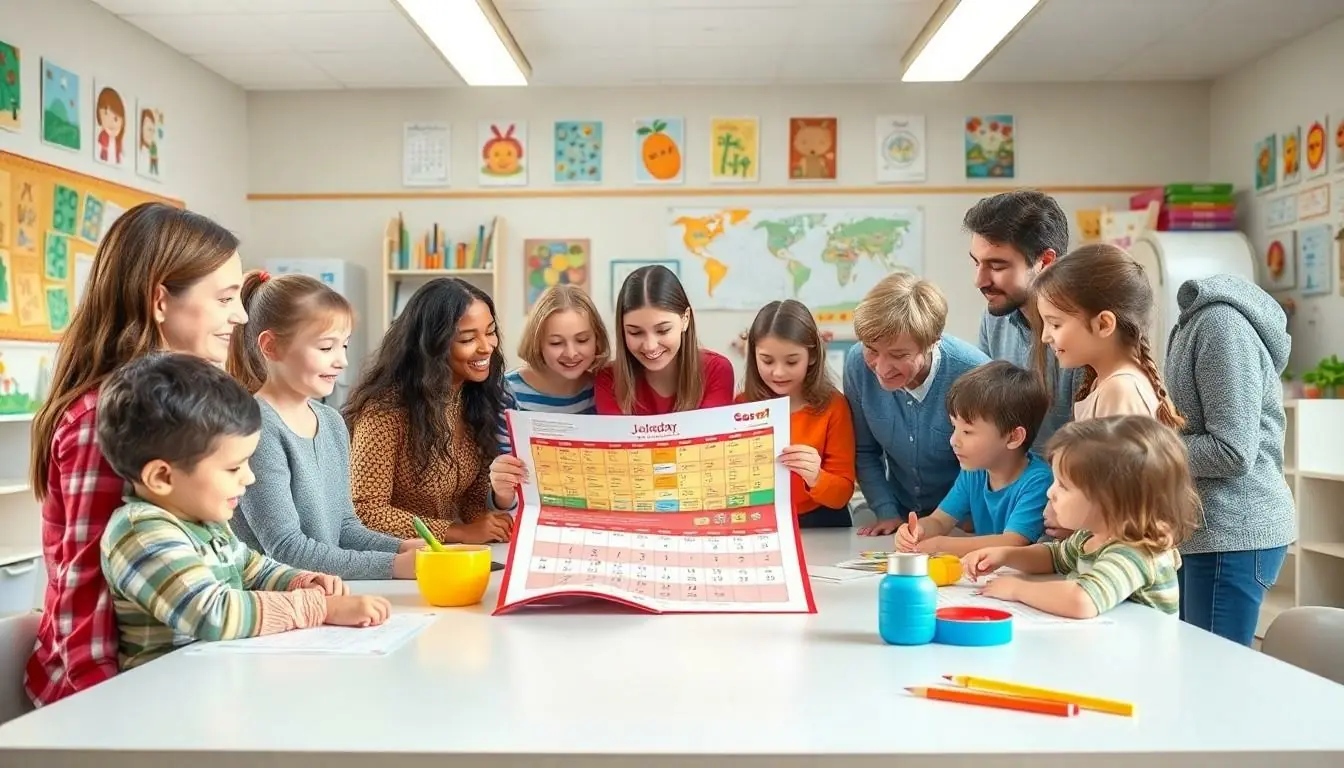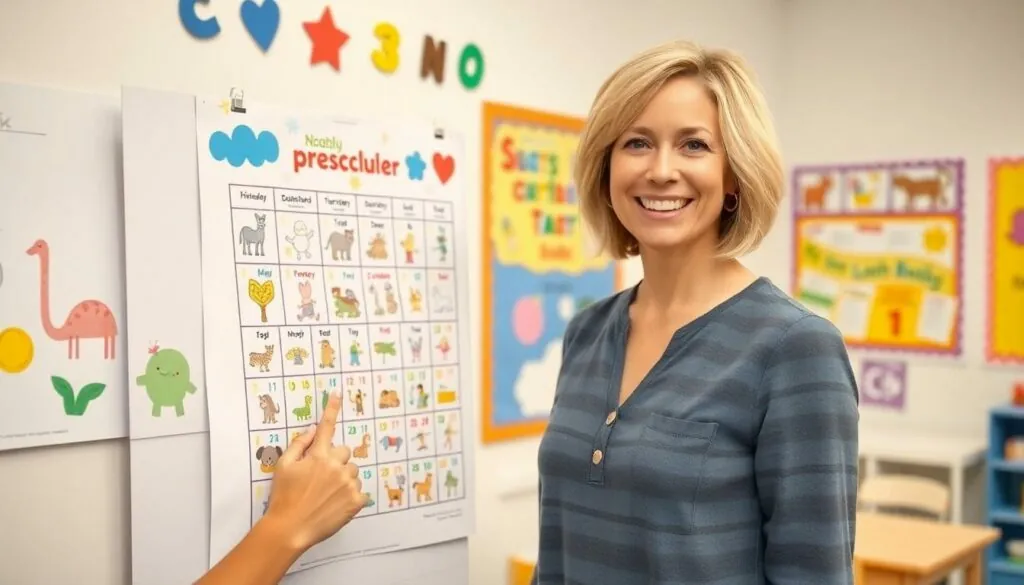Every parent knows that keeping track of a preschooler’s schedule can feel like trying to herd cats. Between playdates, nap times, and snack breaks, it’s a whirlwind of activity. Enter the preschool calendar—a magical tool that transforms chaos into order, making life a little easier for both parents and tiny tots.
Table of Contents
ToggleOverview of Preschool Calendars
A preschool calendar serves as an essential tool for parents managing their children’s activities. It provides a structured framework to organize events such as playdates, nap times, and snack breaks. Various formats exist for preschool calendars, including wall charts, planners, and digital apps. Each option offers unique benefits, allowing flexibility to suit different family needs.
Specific details often included in these calendars are school holidays, special events, and weekly lesson themes. Parents benefit from visual cues that highlight important dates, aiding memory recall and reducing confusion. Daily routines feature prominently, helping children anticipate activities throughout the day.
Many preschools distribute their calendars at the beginning of each term, ensuring that families stay informed. A well-maintained calendar fosters a sense of stability, encouraging children to engage in their planned activities. Parents might also use these calendars to communicate with caregivers, ensuring everyone is on the same page.
Online resources provide templates for creating customized preschool calendars, making them accessible for parents. Options range from simple spreadsheets to elaborate software programs, catering to varying preferences. Visual appeal enhances usability, attracting both parents and children alike.
Incorporating elements like stickers or drawings can make the calendar interactive for children. This engagement reinforces the connection between daily activities and their enjoyment. Preschool calendars contribute to smoother mornings, helping families navigate busy days with efficiency.
Importance of a Preschool Calendar

A preschool calendar serves as an essential resource for organizing daily activities. This tool simplifies scheduling for both parents and children.
Benefits for Parents
Parents experience multiple advantages from utilizing a preschool calendar. Organization becomes easier as families can track playdates, nap times, and important events. Clarity in scheduling reduces stress significantly, allowing parents to stay informed about their child’s school activities. Shared calendars enhance communication with caregivers, ensuring everyone is on the same page regarding the child’s needs. Parents can anticipate changes in the routine, leading to smoother transitions during busy mornings. Customizable templates found online empower families to personalize their calendars according to specific priorities.
Benefits for Educators
Educators also benefit significantly from a well-structured preschool calendar. This tool helps teachers plan lessons and activities effectively throughout the year. Structured schedules foster consistency, which allows children to thrive in a predictable environment. Engagement increases when educators incorporate themed weeks, maintaining children’s interest in learning. Calendars enable communication with parents, facilitating a collaborative approach to education. Preschools that distribute calendars create a sense of community, encouraging families to participate in special events and activities. Overall, the structured framework supports a focused learning experience for young children.
Key Components of a Preschool Calendar
A preschool calendar includes several key components that help organize daily routines and encourage learning.
Daily Activities
Daily activities form the backbone of a preschooler’s schedule. Parents and educators can use these calendars to highlight essential tasks like circle time, snack breaks, and outdoor play. By including time slots for each activity, clarity improves, reducing the chances of confusion. Visual aids can directly engage young learners, making it easier for them to anticipate what comes next. Consistent routines support children’s emotional security, as they thrive in predictable environments. Each day’s plan provides a roadmap that guides both parents and children, fostering smoother transitions throughout the day. Frequent updates keep the calendar relevant, reinforcing familiarity with daily activities.
Monthly Themes
Monthly themes bring excitement and structure to the preschool experience. Implementing these themes allows educators to explore new topics each month, such as animals, seasons, or community helpers. This approach promotes engagement, sparking children’s curiosity while maintaining focus on educational goals. Aligning daily activities with these themes enhances learning outcomes, ensuring children grasp key concepts effectively. Parents can also contribute by discussing the monthly theme at home, boosting reinforcement and retention. Integrating diverse materials, such as books and crafts related to the theme, enriches the learning environment. These themed months create opportunities for collaboration between home and school, fostering a sense of community while supporting children’s development.
Tips for Creating an Effective Preschool Calendar
Creating an effective preschool calendar involves thoughtful planning and design. Start by including all significant dates such as school holidays, special events, and themed weeks. Parents and educators should ensure that all key information is easily accessible.
Choose a format that best suits the family’s needs, whether that’s a printed wall chart, a monthly planner, or a digital app. Each format offers unique advantages, such as visual appeal in wall charts or convenience in digital options.
Incorporate colors and images to make the calendar engaging for children. Colors can symbolize different themes or activities, while images serve as visual cues that enhance memory.
Regular updates are essential to maintain relevance. calendars should reflect changes in schedules or new events promptly to reduce confusion. Include reminders for important activities, such as field trips or celebrations, to keep parents informed.
Encourage interactivity by adding stickers or space for children to mark completed activities. Interactive elements enhance engagement and promote a sense of ownership.
Involve children in the calendar creation process. They can help select themes or colors, fostering excitement and investment in their daily activities.
Lastly, communicate with caregivers using the calendar as a tool. A clear calendar ensures everyone aligns on important events and schedules, promoting smoother transitions and reducing stress.
Popular Preschool Calendar Formats
Numerous formats for preschool calendars exist, each catering to different family preferences and needs. Wall charts, often colorful and easy to read, serve as visual reminders in common areas. Parents appreciate their visibility, allowing quick reference for upcoming events or daily activities.
Planners provide another popular option, offering parents the ability to jot down notes and reminders directly. These planners encourage a hands-on approach where families can personalize entries for playdates, special occasions, or school activities.
Digital apps deliver convenience through technology. Many parents prefer these due to their accessibility on mobile devices, enabling them to track schedules and update events anytime, anywhere. Notifications can alert parents to important dates, ensuring nothing gets overlooked.
Printable templates also attract attention. These customizable options allow families to choose designs that resonate with their children’s interests. Parents can incorporate seasonal themes, making the calendar visually appealing while engaging young learners.
Interactive features enhance various formats, encouraging children’s involvement. Stickers, for example, turn marking special days into a fun activity. Children often enjoy placing stickers next to upcoming events, fostering excitement about what’s planned.
Classroom calendars provide a structured framework in educational settings. Educators regularly display these calendars, helping children understand their routines, holidays, and special events. Familiarity with the calendar promotes a sense of security in young children.
Combining multiple formats can optimize effectiveness. Families might choose to hang a wall chart while using a planner for detailed scheduling. This approach supports busy parents and helps children grasp the daily structure, making life easier for everyone involved.
A preschool calendar is more than just a scheduling tool; it’s a vital resource for families navigating the daily demands of early childhood. By providing structure and clarity, these calendars help parents manage their children’s activities while fostering a sense of security for young learners. With various formats available, families can choose what best suits their needs, enhancing engagement through interactive elements.
Incorporating a preschool calendar into daily life not only streamlines routines but also promotes communication between parents and educators. This collaborative approach supports children’s development and ensures everyone is on the same page. Embracing the benefits of a preschool calendar can lead to smoother mornings and a more organized, fulfilling experience for both parents and preschoolers alike.






